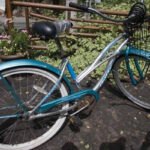Understanding the names of bike parts is essential for every cyclist, whether you’re a beginner or a seasoned enthusiast. Knowing Bike Parts Names not only helps you communicate effectively with mechanics and fellow riders but also enhances your understanding of bike maintenance and repair. This guide provides a detailed overview of bicycle anatomy, covering everything from the frame to the smallest components.
 Bike Frame Diagram
Bike Frame Diagram
Exploring the Bike Frame Parts
The bike frame is the core structure, the skeleton upon which all other components are mounted. Bike frames are designed for strength, lightness, and stiffness, and materials have evolved from traditional steel to modern aluminum alloys, carbon fiber, and titanium for high-performance bikes. The frame, when combined with the fork, is often referred to as the frameset.
The most prevalent frame design is the diamond frame, characterized by two interconnected triangles formed by six main tubes. Let’s break down the key bike frame parts names:
Top Tube
Often called the cross-bar, the top tube is the horizontal tube you typically straddle when getting on or off a bike. It usually runs parallel to the ground, though some designs feature angled or absent top tubes for easier mounting and dismounting, particularly in step-through or mixte frames.
Head Tube
Located at the front of the frame, the head tube is a short, cylindrical tube housing the headset. This crucial component facilitates steering by connecting the handlebars to the fork, allowing the front wheel to turn smoothly.
Down Tube
The down tube is a long, usually thick tube extending from the head tube, just below the handlebars, down to the pedal area. It’s a prominent part of the frame, often displaying the bike brand’s logo and commonly equipped with bottle cage mounts for hydration.
Seat Tube
The seat tube runs vertically from the saddle area down to the pedals. It accommodates the seat post, which slides inside to adjust saddle height. Adjusting the seat post within the seat tube allows riders to customize their riding position for optimal comfort and efficiency.
Seat Stays
Seat stays are thinner tubes connecting the upper part of the seat tube, near the saddle, to the rear wheel hub area. They provide vertical compliance for a smoother ride and terminate at the rear dropouts, which secure the rear wheel axle.
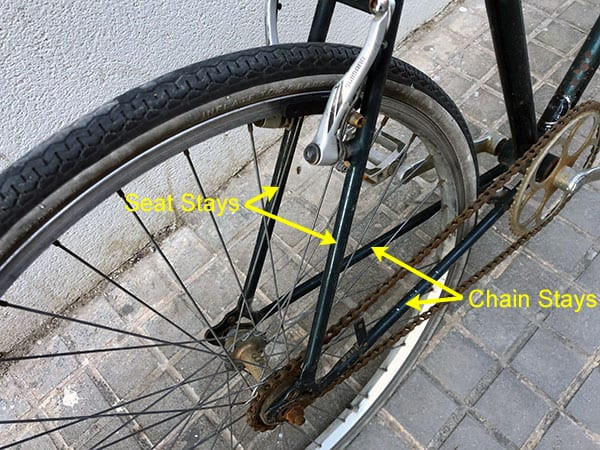 Seat and Chain Stays
Seat and Chain Stays
Chain Stays
Chain stays are also thinner tubes, running horizontally from the bottom bracket area (near the pedals) to the rear wheel hub. They are positioned parallel to the ground and alongside the bike chain, hence their name. Chain stays play a vital role in power transfer and rear wheel stability.
Front Bike Parts: Control and Steering
The front section of a bike is crucial for control and steering. Let’s explore the bike parts names found here:
Fork
The fork is the component that holds the front wheel and connects it to the frame. It has fork blades that extend down on either side of the wheel, and a steerer tube at the top, which is concealed within the head tube and connects to the headset.
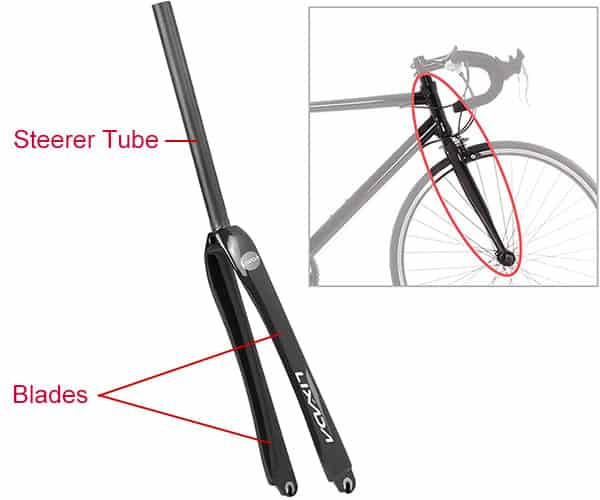 Bike Fork Diagram
Bike Fork Diagram
Headset
The headset is a set of bearings and races nestled inside the head tube. It allows the fork’s steerer tube to rotate smoothly, enabling steering. A well-functioning headset is crucial for responsive and effortless bike handling.
Stem
The stem is the connecting link between the fork’s steerer tube and the handlebars. It projects forward from the top of the head tube, and handlebars are clamped to its end. Stem length and angle influence rider position and handling characteristics.
Handlebars
Handlebars are your primary interface for steering the bicycle. Attached to the stem, they come in various shapes and sizes. Flat handlebars are common on mountain, hybrid, and urban bikes, offering upright riding positions. Drop handlebars are characteristic of road bikes, providing multiple hand positions for varied terrain and aerodynamics.
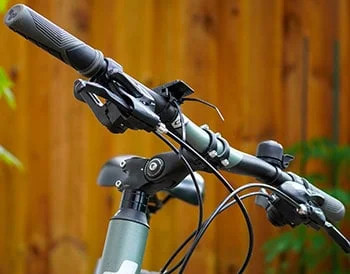 Straight handlebars
Straight handlebars
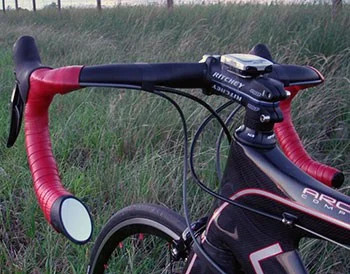 Drop handlebars
Drop handlebars
Brake Levers
Brake levers, mounted on the handlebars, are used to activate the brakes and control speed. Some brake levers integrate gear shifters, forming combination units called “brake shifters” or “brifters,” especially common on road bikes. Brake cables run from the levers to the brake calipers at the wheels.
Brakes (Rim vs Disc)
Bicycles utilize two main types of brakes: rim brakes and disc brakes. Rim brakes, applying friction to the wheel rim, are traditional, lightweight, and easy to maintain. However, their performance can be compromised in wet conditions.
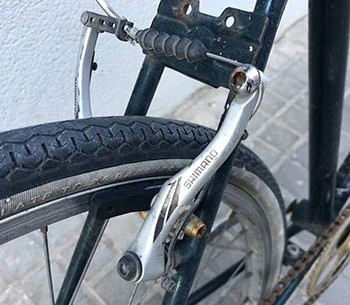 Rim Brakes
Rim Brakes
Disc brakes, on the other hand, use a rotor attached to the wheel hub, offering consistent stopping power even in wet or muddy conditions and are known for their robustness. Originally prevalent in mountain biking, disc brakes are increasingly found on all types of bikes due to their superior performance.
 Disc Brakes
Disc Brakes
Bike Wheel Parts: Rolling Efficiency
Wheels are fundamental for movement. A standard bicycle has two wheels, collectively called a wheelset. Tricycles have three. Each wheel comprises several key components:
Hub
The hub is the central part of the wheel, containing the axle, bearings, and hub shell. The hub shell is the outer body to which spokes attach. The axle is a rod passing through the hub center, securing the wheel to the frame. Bearings are located between the axle and shell, allowing the wheel to rotate smoothly.
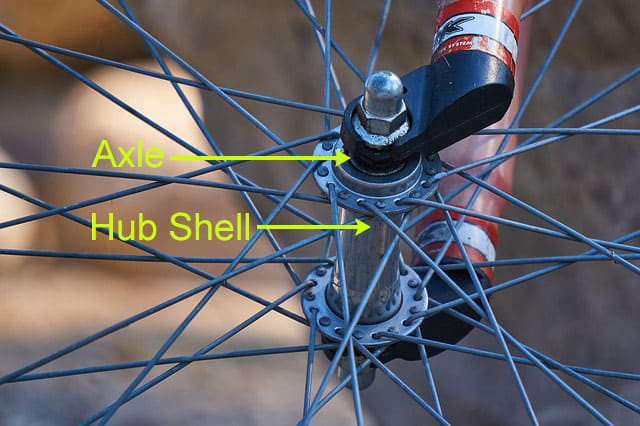 Wheel Hub Diagram
Wheel Hub Diagram
Rim
The rim is the outer circular part of the wheel, providing the mounting surface for the tire. Historically made of steel, modern rims are primarily aluminum alloy. Rims designed for rim brakes have a smooth braking surface on their sides for brake pad contact.
Spokes
Spokes are wires or rods connecting the hub to the rim. They distribute load and tension, creating a strong, lightweight, and resilient wheel structure capable of supporting rider weight and absorbing riding forces. Nipples, located where spokes meet the rim, allow for spoke tension adjustment, crucial for wheel trueness.
Tire
The tire is the rubber outer covering mounted on the rim, providing traction and cushioning. Bike tires are typically constructed from rubber-impregnated fabric with a thicker outer tread layer. They enclose an inner tube filled with air, providing suspension and rolling efficiency.
Valve (Schrader vs Presta)
The valve allows inflation and deflation of the inner tube. Two common valve types are Schrader and Presta. Schrader valves are wider, robust, and also used in car tires. Presta valves are narrower, often found on performance bikes, and may require an adapter for some pumps.
 Schrader tire valve
Schrader tire valve
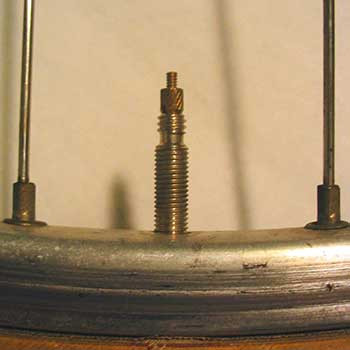 Presta tire valve
Presta tire valve
Rear Bike Parts: Drivetrain and Gears
The rear of the bike houses the drivetrain, responsible for propulsion. Key bike parts names in this area include:
Crankset / Chainset
The crankset is the assembly your legs power to propel the bike. It includes chainrings, which the chain engages with, and crank arms, onto which pedals are attached. Chainrings are the front gears. Single-speed bikes have one chainring, while geared bikes can have up to three. The crankset connects to the frame via the bottom bracket, to the rear wheel through the chain, and to the rider via the pedals.
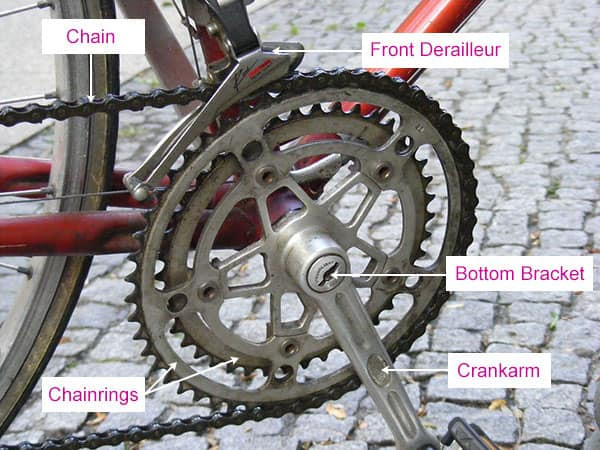 Crankset Diagram
Crankset Diagram
Pedals
Pedals are the interface between your feet and the bike’s drivetrain. Pushing down on the pedals rotates the crankset and drives the bike forward. There are two main pedal types: flat/platform pedals for general use and clip-in pedals (also called clipless pedals), which require special shoes with cleats that lock into the pedal for enhanced pedaling efficiency and control.
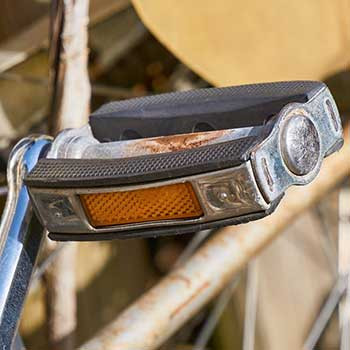 Flat pedal
Flat pedal
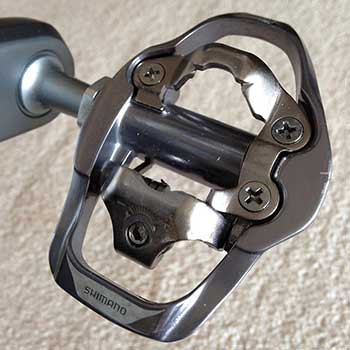 Clip-in pedal
Clip-in pedal
Bottom Bracket
The bottom bracket is the bearing system allowing the crank arms to rotate smoothly within the frame. It consists of a spindle, to which the crankset attaches, and bearings. The bottom bracket is housed within the bottom bracket shell at the frame’s base.
Chain
The bike chain is the vital link transmitting power from the crankset to the rear wheel. It loops around the chainrings, runs along the chain stay, and engages with the cassette sprockets on the rear wheel.
Front Derailleur
The front derailleur is a mechanism that shifts the chain between different chainrings on bikes with multiple front gears. It’s only present on bikes with more than one chainring, allowing for gear changes to suit varying terrains.
Cassette / Cogset
The cassette is a cluster of sprockets (cogs) of varying sizes mounted on the rear wheel hub. These cogs are the rear gears. Bikes without gears have a single cog. The cassette, in combination with the rear derailleur, provides a range of gear ratios for efficient pedaling.
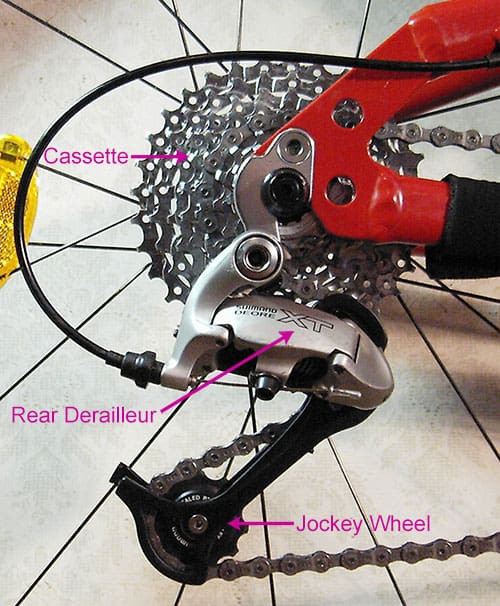 Bike Gear Diagram
Bike Gear Diagram
Rear Derailleur
The rear derailleur is responsible for moving the chain across the cassette sprockets when shifting gears. It works in conjunction with the jockey wheel to maintain chain tension and facilitate smooth gear changes. Rear derailleurs are essential for bikes with gears.
Jockey Wheel
The jockey wheel, or derailleur pulleys, are small toothed wheels on the rear derailleur that guide the chain and maintain tension. They ensure smooth and precise gear changes by managing chain slack as it moves between different sized sprockets.
Bike Seat Parts: Comfort and Fit
The seat area is vital for rider comfort and efficient pedaling. Let’s review the bike seat parts names:
Saddle
The saddle is what you sit on. Bike saddles come in numerous shapes and sizes to suit different riding styles, anatomies, and preferences. All saddles have saddle rails underneath, which attach to the seat post via a saddle clamp.
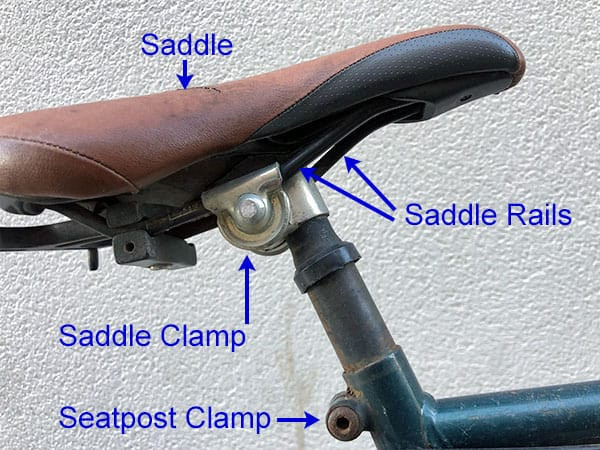 Bike Seat Parts
Bike Seat Parts
Seat Post
The seat post is a tube inserted into the seat tube, connecting the saddle to the frame. Its height is adjustable to set the correct saddle position. A seat post clamp, located at the top of the seat tube, secures the seat post at the desired height by tightening around the seat tube.
By familiarizing yourself with these bike parts names, you’ll be better equipped to understand your bicycle, communicate effectively about maintenance or repairs, and deepen your appreciation for the mechanics of cycling.

